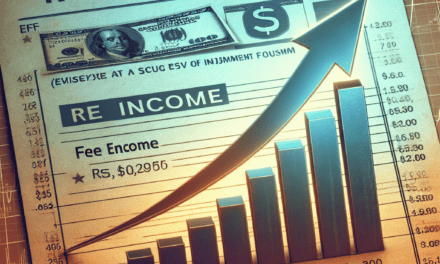“Balancing Act: Trump’s Spending Plans and Wall Street’s Debt Dilemma”
Introduction
Wall Street is closely monitoring the potential impact of former President Donald Trump’s spending plans on the national debt, as financial markets react to policy proposals that could significantly alter the economic landscape. Investors and analysts are evaluating the implications of increased government expenditure on infrastructure, defense, and other sectors, considering how these initiatives might influence fiscal stability and interest rates. The Morning Brief delves into the complexities of these spending strategies, assessing their potential to drive economic growth while also weighing the risks of escalating debt levels. As stakeholders navigate this uncertain terrain, the balance between stimulating the economy and maintaining fiscal responsibility remains a focal point of discussion.
Analyzing Trump’s Spending Plans: Implications for Wall Street
In recent months, Wall Street has been closely monitoring the potential implications of former President Donald Trump’s proposed spending plans on the national debt. As investors and financial analysts scrutinize these proposals, there is a growing concern about how increased government spending might affect the broader economic landscape. Trump’s spending plans, which include significant investments in infrastructure, defense, and tax cuts, have sparked a debate about their long-term impact on the national debt and the financial markets.
To begin with, Trump’s infrastructure plan, which aims to revitalize the nation’s roads, bridges, and public transportation systems, is expected to require substantial funding. While such investments could stimulate economic growth by creating jobs and improving efficiency, they also raise questions about how they will be financed. The potential for increased borrowing to fund these projects has led to concerns about the national debt, which has already reached unprecedented levels. As a result, Wall Street is weighing the potential benefits of infrastructure improvements against the risks associated with higher debt levels.
Moreover, Trump’s defense spending proposals have also drawn attention. The former president has consistently advocated for a stronger military, which necessitates increased defense budgets. While a robust defense sector can contribute to economic stability and national security, the financial burden of such spending cannot be overlooked. Investors are particularly interested in understanding how these expenditures will be balanced with other fiscal priorities and what impact they might have on interest rates and inflation.
In addition to infrastructure and defense, Trump’s tax policies are another focal point for Wall Street. The proposed tax cuts aim to stimulate economic growth by increasing disposable income for individuals and businesses. However, critics argue that without corresponding cuts in government spending, these tax reductions could exacerbate the national debt. The potential for increased deficits has led to speculation about how the government might address these fiscal challenges, with some suggesting that future tax increases or spending cuts could be necessary to maintain fiscal balance.
As Wall Street evaluates these spending plans, it is essential to consider the broader economic context. The U.S. economy is currently navigating a complex landscape characterized by inflationary pressures, supply chain disruptions, and global economic uncertainties. In this environment, the impact of Trump’s spending proposals on interest rates is of particular concern. Higher debt levels could lead to increased borrowing costs, which might, in turn, affect consumer spending and business investment. Consequently, financial markets are closely monitoring signals from the Federal Reserve regarding potential interest rate adjustments in response to fiscal policy changes.
Furthermore, the international implications of Trump’s spending plans cannot be ignored. As the U.S. government potentially increases its borrowing, global investors may reassess their appetite for U.S. Treasury securities. This could influence exchange rates and capital flows, with ripple effects across global financial markets. Wall Street is keenly aware of these dynamics and is actively analyzing how shifts in U.S. fiscal policy might impact international economic relations.
In conclusion, Wall Street’s assessment of Trump’s spending plans is a multifaceted analysis that considers the potential benefits of economic growth against the risks of increased national debt. As investors and analysts continue to evaluate these proposals, the interplay between fiscal policy, interest rates, and global economic conditions will remain a critical focus. The financial markets will undoubtedly keep a watchful eye on developments in this area, as the implications of these spending plans unfold in the months and years ahead.
The Debt Dilemma: How Trump’s Fiscal Policies Affect Financial Markets
In recent years, Wall Street has been closely monitoring the fiscal policies emanating from the Trump administration, particularly focusing on the implications of increased government spending on the national debt. As investors and financial analysts scrutinize these developments, the potential impact on financial markets becomes a subject of intense debate. The administration’s ambitious spending plans, aimed at stimulating economic growth and revitalizing infrastructure, have sparked discussions about the long-term sustainability of such fiscal strategies. Consequently, the financial community is weighing the benefits of short-term economic gains against the risks of escalating national debt.
To begin with, the Trump administration’s fiscal policies have been characterized by significant tax cuts and increased government spending. These measures, while designed to spur economic growth, have raised concerns about their impact on the federal budget deficit. The tax cuts, primarily benefiting corporations and high-income individuals, were intended to boost investment and consumer spending. However, critics argue that these cuts have disproportionately favored the wealthy, leading to a widening income gap and placing additional strain on government finances.
Moreover, the administration’s focus on infrastructure development has necessitated substantial government expenditure. While infrastructure investment is widely regarded as essential for long-term economic growth, the challenge lies in financing these projects without exacerbating the national debt. The administration has proposed public-private partnerships as a solution, but questions remain about the feasibility and effectiveness of such arrangements. As a result, financial markets are left to grapple with the uncertainty surrounding the funding of these initiatives.
In addition to domestic considerations, the global economic landscape plays a crucial role in shaping the impact of Trump’s fiscal policies on financial markets. The interconnectedness of global economies means that changes in U.S. fiscal policy can have far-reaching effects. For instance, increased government borrowing to finance spending could lead to higher interest rates, affecting not only domestic investment but also international capital flows. Consequently, investors are keenly aware of the potential for volatility in global markets as they assess the implications of U.S. fiscal policy decisions.
Furthermore, the relationship between fiscal policy and monetary policy is a critical factor in understanding the broader economic impact. The Federal Reserve’s response to increased government spending and rising debt levels is of particular interest to financial markets. Should the Fed decide to raise interest rates to counteract inflationary pressures, the cost of borrowing could increase, potentially dampening economic growth. This delicate balance between fiscal and monetary policy underscores the complexity of managing economic growth while maintaining financial stability.
As Wall Street continues to evaluate the impact of Trump’s spending plans on the national debt, the debate over fiscal responsibility versus economic stimulus remains at the forefront. Proponents of increased spending argue that it is necessary to address pressing infrastructure needs and support economic growth. However, critics caution that unchecked spending could lead to unsustainable debt levels, ultimately undermining economic stability.
In conclusion, the financial markets are navigating a complex landscape as they assess the implications of the Trump administration’s fiscal policies. The challenge lies in balancing the immediate benefits of economic stimulus with the long-term risks associated with rising national debt. As investors and analysts weigh these factors, the ongoing debate over fiscal policy and its impact on financial markets is likely to persist, shaping the economic discourse for years to come.
Wall Street’s Reaction to Increased Government Spending Under Trump
In recent years, Wall Street has been closely monitoring the fiscal policies emanating from Washington, particularly those introduced during the Trump administration. The focus has been on the potential implications of increased government spending on the national debt. As investors and analysts scrutinize these developments, the financial community is keenly aware of the delicate balance between stimulating economic growth and managing fiscal responsibility.
The Trump administration’s spending plans, characterized by significant investments in infrastructure, defense, and tax cuts, have sparked a vigorous debate among economists and financial experts. On one hand, proponents argue that such spending is necessary to invigorate the economy, create jobs, and enhance the nation’s competitive edge. They contend that strategic investments, particularly in infrastructure, can yield long-term benefits by improving productivity and efficiency. Moreover, tax cuts are seen as a means to increase disposable income for individuals and businesses, potentially leading to higher consumer spending and investment.
However, these optimistic projections are tempered by concerns over the burgeoning national debt. Critics caution that unchecked government spending could exacerbate fiscal imbalances, leading to higher interest rates and inflationary pressures. The Congressional Budget Office has projected that the national debt could reach unprecedented levels if current spending trends continue. This scenario poses a significant risk to the economy, as rising debt levels may crowd out private investment and necessitate higher taxes in the future to service the debt.
Wall Street’s reaction to these spending plans has been mixed, reflecting the complexity of the issue. On one hand, the stock market has experienced periods of robust growth, buoyed by investor optimism regarding economic expansion and corporate profitability. The anticipation of increased government contracts and consumer spending has driven up stock prices in sectors such as construction, defense, and consumer goods. Additionally, the promise of deregulation and business-friendly policies has further fueled market enthusiasm.
Conversely, bond markets have exhibited signs of caution, as investors weigh the potential for increased borrowing and inflation. The yield on U.S. Treasury bonds, a key indicator of investor sentiment, has fluctuated in response to fiscal policy announcements. Higher yields suggest that investors are demanding greater compensation for the perceived risks associated with rising debt levels. This dynamic underscores the tension between short-term economic gains and long-term fiscal sustainability.
In navigating these complexities, Wall Street analysts are employing a range of strategies to assess the potential impact of government spending on the financial markets. They are closely monitoring economic indicators such as GDP growth, employment rates, and inflation to gauge the effectiveness of fiscal policies. Additionally, analysts are evaluating the Federal Reserve’s monetary policy stance, as interest rate adjustments could influence the cost of borrowing and investment decisions.
In conclusion, Wall Street’s reaction to increased government spending under the Trump administration is a reflection of the broader economic debate surrounding fiscal policy and debt management. While the potential for economic growth and market gains is enticing, the risks associated with rising debt levels cannot be ignored. As investors and policymakers continue to navigate this complex landscape, the challenge will be to strike a balance that fosters sustainable economic growth while maintaining fiscal discipline. The outcome of this balancing act will have profound implications for the financial markets and the broader economy in the years to come.
Trump’s Economic Strategy: Balancing Growth and Debt Concerns
In recent months, Wall Street has been closely monitoring the potential implications of former President Donald Trump’s proposed spending plans on the national debt. As the financial sector evaluates these strategies, there is a growing discourse on how such fiscal policies might influence economic growth and debt sustainability. Trump’s economic strategy, characterized by ambitious infrastructure projects and tax cuts, aims to stimulate growth and enhance the nation’s competitive edge. However, these initiatives also raise concerns about their impact on the federal deficit and long-term debt levels.
To begin with, Trump’s spending plans are designed to inject significant capital into the economy, with a particular focus on revitalizing infrastructure. Proponents argue that such investments are crucial for modernizing the nation’s roads, bridges, and public transportation systems, which in turn could create jobs and boost productivity. By enhancing the country’s infrastructure, the administration hopes to lay the groundwork for sustained economic growth. Moreover, tax cuts are intended to increase disposable income for individuals and businesses, thereby encouraging consumer spending and investment.
Nevertheless, the potential benefits of these policies must be weighed against the risks associated with increasing the national debt. Critics caution that without corresponding revenue increases or spending cuts in other areas, these plans could exacerbate the federal deficit. The Congressional Budget Office has previously warned that rising debt levels could lead to higher interest rates, crowding out private investment and ultimately slowing economic growth. Furthermore, an elevated debt burden may limit the government’s ability to respond to future economic crises, as it would have less fiscal flexibility to implement counter-cyclical measures.
In light of these concerns, Wall Street analysts are carefully assessing the potential impact of Trump’s economic strategy on financial markets. Investors are particularly interested in how these policies might influence interest rates, inflation, and overall market stability. For instance, if the spending plans lead to higher inflation, the Federal Reserve may be compelled to raise interest rates more aggressively, which could affect borrowing costs for businesses and consumers. Additionally, increased government borrowing could lead to a rise in bond yields, impacting the fixed-income market.
Despite these challenges, some analysts remain optimistic about the potential for Trump’s spending plans to drive economic growth. They argue that if implemented effectively, these policies could lead to a virtuous cycle of increased investment, job creation, and higher tax revenues, which could help offset the initial rise in debt. Moreover, by prioritizing infrastructure and other growth-enhancing investments, the administration may be able to achieve a more balanced approach to fiscal policy.
In conclusion, the debate over Trump’s economic strategy highlights the complex interplay between growth and debt concerns. As Wall Street continues to weigh the potential outcomes of these spending plans, it is clear that careful consideration must be given to both the short-term benefits and long-term risks. Ultimately, the success of these policies will depend on their ability to stimulate sustainable economic growth while maintaining fiscal responsibility. As such, ongoing analysis and dialogue will be essential in navigating the challenges and opportunities presented by this ambitious economic agenda.
Investor Sentiment: Navigating Market Uncertainty Amid Trump’s Spending
Investor sentiment is currently navigating a complex landscape as Wall Street weighs the potential impact of former President Donald Trump’s spending plans on national debt. The financial markets, always sensitive to fiscal policy changes, are now grappling with the implications of increased government expenditure. This situation is further complicated by the broader economic context, which includes ongoing concerns about inflation and interest rates. As investors attempt to make sense of these dynamics, they are faced with the challenge of balancing optimism about economic growth with caution regarding fiscal sustainability.
To begin with, Trump’s spending proposals, which include significant investments in infrastructure and defense, have the potential to stimulate economic growth. Such initiatives could lead to job creation and increased consumer spending, thereby boosting corporate profits and, by extension, stock market performance. However, the anticipated rise in government spending also raises questions about how these expenditures will be financed. If funded through increased borrowing, this could lead to a substantial rise in the national debt, a prospect that has historically been a source of concern for investors.
Moreover, the potential increase in national debt could have far-reaching implications for interest rates. As the government borrows more, it may need to offer higher yields to attract investors to its bonds, which could, in turn, lead to an increase in interest rates across the economy. Higher interest rates can have a dampening effect on economic growth by making borrowing more expensive for businesses and consumers. This scenario presents a conundrum for investors, who must weigh the benefits of short-term economic stimulus against the risks of long-term fiscal instability.
In addition to these considerations, the current economic environment adds another layer of complexity to the situation. Inflation, which has been a persistent concern for policymakers and investors alike, could be exacerbated by increased government spending. If inflationary pressures rise, the Federal Reserve may be compelled to tighten monetary policy more aggressively, potentially leading to higher interest rates and increased market volatility. This possibility underscores the importance of closely monitoring fiscal policy developments and their potential impact on inflationary trends.
Furthermore, investor sentiment is also influenced by geopolitical factors, which can amplify market uncertainty. Trump’s spending plans, particularly those related to defense, may have implications for international relations and global trade dynamics. Investors must remain vigilant in assessing how these factors could affect market stability and economic growth prospects.
In light of these complexities, investors are adopting a cautious approach, seeking to diversify their portfolios and hedge against potential risks. This strategy involves a careful analysis of market trends and a focus on sectors that may benefit from increased government spending, such as infrastructure and defense. At the same time, investors are also considering the potential impact of rising interest rates on sectors that are more sensitive to borrowing costs, such as real estate and consumer discretionary.
In conclusion, as Wall Street weighs the impact of Trump’s spending plans on national debt, investor sentiment is characterized by a delicate balance between optimism and caution. The interplay of fiscal policy, interest rates, inflation, and geopolitical factors creates a challenging environment for market participants. By staying informed and adopting a strategic approach, investors can navigate this uncertainty and position themselves to capitalize on potential opportunities while mitigating risks.
Fiscal Policy and Market Volatility: Wall Street’s Perspective on Trump
In recent years, Wall Street has been closely monitoring the fiscal policies emanating from Washington, particularly those proposed during the Trump administration. The focus has been on understanding how these policies, especially spending plans, could impact the national debt and, consequently, market volatility. As investors and analysts scrutinize these developments, the interplay between fiscal policy and market dynamics becomes increasingly significant.
The Trump administration’s approach to fiscal policy was characterized by substantial tax cuts and increased government spending. These measures were intended to stimulate economic growth, but they also raised concerns about the burgeoning national debt. The Tax Cuts and Jobs Act of 2017, a cornerstone of Trump’s economic agenda, aimed to reduce the tax burden on individuals and corporations. While proponents argued that these cuts would spur investment and job creation, critics warned of the potential for increased deficits and debt.
As Wall Street weighed these factors, the immediate market response was mixed. On one hand, the tax cuts were initially welcomed by investors, as they were expected to boost corporate profits and, by extension, stock prices. This optimism was reflected in the bullish trends observed in the stock market during the early years of the Trump presidency. However, as the implications of rising deficits became clearer, concerns about long-term fiscal sustainability began to surface.
Transitioning to the broader economic landscape, the increased government spending under Trump further complicated the fiscal outlook. Initiatives such as infrastructure development and defense spending were seen as necessary investments, yet they also contributed to the growing debt burden. Wall Street analysts were tasked with assessing how these spending plans would affect interest rates and inflation, both of which are critical factors in market stability.
The relationship between fiscal policy and interest rates is particularly noteworthy. As government borrowing increases to finance spending, there is a potential for upward pressure on interest rates. Higher rates can lead to increased borrowing costs for businesses and consumers, potentially dampening economic growth. Wall Street’s attention was thus focused on the Federal Reserve’s response to these fiscal developments. The central bank’s monetary policy decisions, including interest rate adjustments, were closely watched as they sought to balance economic growth with inflation control.
Moreover, the global context cannot be ignored when considering the impact of U.S. fiscal policy. International investors, who hold a significant portion of U.S. debt, are sensitive to changes in fiscal stability. Any perceived risk of unsustainable debt levels could lead to shifts in investment patterns, affecting currency values and global financial markets. Wall Street’s perspective on Trump’s spending plans, therefore, extended beyond domestic borders, encompassing a broader view of international economic relations.
In conclusion, Wall Street’s assessment of Trump’s spending plans and their impact on national debt is a complex interplay of fiscal policy, market volatility, and global economic considerations. While the immediate effects of tax cuts and increased spending were initially positive for market sentiment, the long-term implications for debt sustainability and interest rates remain a concern. As investors continue to navigate these challenges, the lessons learned from this period underscore the importance of prudent fiscal management in maintaining market stability and economic growth.
Long-term Debt Impact: Evaluating Trump’s Spending Plans on Wall Street
In recent years, Wall Street has been closely monitoring the potential long-term impacts of former President Donald Trump’s spending plans on the national debt. As the financial sector seeks to understand the implications of these policies, investors and analysts are evaluating how increased government spending might influence economic growth, interest rates, and the overall fiscal health of the United States. The focus on Trump’s spending initiatives, which include significant investments in infrastructure, defense, and tax cuts, has sparked a complex debate about the balance between stimulating economic growth and managing the national debt.
To begin with, Trump’s spending plans were designed to boost economic activity by injecting substantial funds into various sectors. Proponents argue that such investments could lead to job creation, improved infrastructure, and enhanced competitiveness on a global scale. By prioritizing these areas, the administration aimed to stimulate demand and drive economic expansion. However, the question remains whether the anticipated economic growth will be sufficient to offset the increase in national debt resulting from these expenditures.
Moreover, the tax cuts implemented during Trump’s tenure have been a focal point of discussion. While they were intended to provide relief to individuals and businesses, thereby encouraging spending and investment, critics contend that the reduction in government revenue could exacerbate the fiscal deficit. This concern is particularly relevant when considering the long-term sustainability of these policies. As tax cuts reduce the government’s income, the ability to fund essential services and repay debt obligations may be compromised, leading to potential challenges in maintaining fiscal stability.
In addition to these considerations, the impact of Trump’s spending plans on interest rates is another critical factor for Wall Street. Increased government borrowing to finance these initiatives could lead to higher interest rates as the demand for credit rises. This, in turn, might affect borrowing costs for businesses and consumers, potentially dampening economic growth. Furthermore, higher interest rates could increase the cost of servicing the national debt, placing additional strain on the federal budget.
Transitioning to the broader implications, the interplay between government spending and national debt is a delicate balancing act. While short-term economic gains are desirable, the long-term consequences of increased debt cannot be overlooked. Investors are particularly concerned about the potential for inflationary pressures, which could erode the purchasing power of consumers and impact corporate profitability. As inflation rises, the Federal Reserve may be compelled to tighten monetary policy, further influencing interest rates and financial markets.
In light of these complexities, Wall Street is keenly aware of the need for prudent fiscal management. The challenge lies in finding a sustainable path that fosters economic growth while ensuring fiscal responsibility. As analysts continue to assess the impact of Trump’s spending plans, they are also considering the broader context of global economic conditions and geopolitical uncertainties. These factors can significantly influence the effectiveness of domestic policies and their long-term implications for the national debt.
In conclusion, the evaluation of Trump’s spending plans on Wall Street underscores the intricate relationship between government policy, economic growth, and fiscal health. While the potential benefits of increased spending are evident, the associated risks and challenges must be carefully managed to ensure a stable and prosperous economic future. As the financial sector navigates these complexities, the focus remains on achieving a balanced approach that supports growth while safeguarding the nation’s fiscal integrity.
Q&A
1. **What are Trump’s spending plans?**
Trump’s spending plans include significant investments in infrastructure, defense, and tax cuts.
2. **How might these plans impact the national debt?**
The plans could substantially increase the national debt due to higher government spending and reduced tax revenue.
3. **What is Wall Street’s main concern regarding these plans?**
Wall Street is concerned about the potential for increased inflation and interest rates as a result of higher debt levels.
4. **How could increased debt affect interest rates?**
Increased debt might lead to higher interest rates as the government competes for borrowing, potentially crowding out private investment.
5. **What sectors might benefit from Trump’s spending plans?**
Sectors like construction, defense, and manufacturing could benefit from increased government spending.
6. **What are potential risks for investors?**
Potential risks include market volatility, inflationary pressures, and the possibility of a government debt crisis.
7. **How are analysts advising investors to prepare?**
Analysts suggest diversifying portfolios, focusing on inflation-protected securities, and monitoring fiscal policy developments closely.
Conclusion
The article “Wall Street Weighs Impact of Trump’s Spending Plans on Debt: Morning Brief” likely discusses the financial community’s analysis of the potential effects of former President Trump’s proposed spending initiatives on the national debt. The conclusion might emphasize that while increased spending could stimulate economic growth and infrastructure development, it also raises concerns about exacerbating the national debt and fiscal sustainability. Investors and analysts are likely weighing the short-term economic benefits against the long-term implications for debt levels and interest rates, with varying opinions on the overall impact on the economy.





